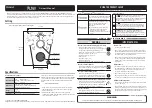
System Overview
R&S
®
ZVA
82
Getting Started 1145.1090.62 ─ 13
The network analyzer provides two additional sets of measurement parameters which
have a unambiguous meaning even if the DUT is measured outside its linear range:
●
"Wave Quantities" provide the power of any of the transmitted or received waves.
●
"Ratios" provide the complex ratio of any combination of transmitted or received
wave quantities.
In contrast to S-, Z- and Y-parameters, wave quantities and ratios are not system-error
corrected. A power calibration can be applied to wave quantities and ratios.
With option R&S ZVA-K6, "True Differential Mode", the analyzer can also determine
balanced wave quantities and ratios.
3.3.2.9
Wave Quantities
A wave quantity measurement provides the power of any of the transmitted or received
waves. The power can be displayed in voltage units (e.g. "V" or "dBmV") or equivalent
power units (e.g. "W" or "dBm").
Examples for using wave quantities
The wave quantities provide the power at the different receive ports of the analyzer.
This is different from an S-parameter measurement, where the absolute power of a lin-
ear device is cancelled. Wave quantities are therefore suitable for the following mea-
surement tasks:
●
Analysis of non-linearities of the DUT.
●
Use of the analyzer as a selective power meter.
To increase the accuracy or correct a possible attenuation in the input signal path,
it is recommended to perform a power calibration.
The notation for wave quantities includes the direction and the test port number. Addi-
tionally, the source port must be specified. The letter a indicates a transmitted wave, b
a received wave.
Measured Quantities
















































